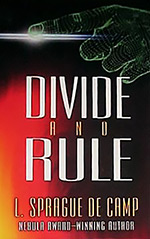
![]() chuhl
chuhl
7/23/2012
![]()
When I saw the synopsis of L. Sprague de Camp's "Divide and Rule," I knew I had to read it. It takes place in the 23rd century in Poughkeepsie, NY. Poughkeepsie happens to be my hometown, and during my Junior Year Abroad in England, they actually called me "the Duke of Poughkeepsie." So this is my story.
Assuming, of course, that I survive to the 23rd century, when the Hudson Valley, like the rest of the planet, will be conquered by "hoppers," aliens who look like oversized kangaroos. The hoppers will ban high tech and reduce America to a state of medieval feudalism. As if that weren't bad enough, Poughkeepsie will be at war with Danbury, CT over high tolls. So it looks like I'll have my work cut out for me.
The point of the story is the juxtaposition of the medieval and the modern. When these New Yorkers talk about the new model Ford, they're not talking about cars, they're talking about suits of armor. And they use 20th-century American slang to describe their chivalric adventures.
The problem for me at first was that de Camp doesn't delve too deeply into the implications of this society beyond the bare description. It's an interesting setup -- let's explore it! It's fun to bandy around names like Baron Peekskill and hear about knights fighting at the Battle of Mt. Kisco, but once the novelty of medieval New York wears off -- and I would think that the novelty would carry me along further than most readers -- then what? The juxtaposition between the medieval and the modern loses its impact when the "modern" now seems a bit quaint to the contemporary reader.
The story starts to fall between two stools -- not quite satisfying as science fiction or as historical novel -- and like a knight it full armor, it has trouble getting up again.
But it does rise up, when our hero finds himself forced to kill a hopper to defend himself and a damsel in distress. In a nicely-observed description of the moment immediately afterwards, DeCamp writes:
"Sir Howard leaned on his sword, waiting for the roaring in his ears to cease. He knew that he had come as near to fainting as he ever had in his life. A few feet away lay the hopper's head, the beady eyes staring blankly. The rest of the hopper lay at his feet, its limbs jerking slightly, pushing the sand up into little piles with its hands and feet. Blue-green blood spread out in a widening pool. A few pine needles gyrated slowly on its surface."
From that moment on, there's no going back, and the story gains new power as our feckless knight-errant changes into a man with a purpose.
"Divide and Rule" is dedicated "To Bob Heinlein," and I imagine that Heinlein must have been pleased with the offering. It's his kind of story, with scrappy, pragmatic characters getting their political education at the hands of a didactic, Wise Old Man. But the resistance leader in this story is a gentler, more patient man than the cantankerous gurus of Heinlein.
And Sir Howard is a bit like the protagonist in a Heinlein juvenile. He's a mature adult, but intellectually and politically he's been kept in a state of arrested adolescence by his alien overlords. Once his consciousness is raised, though, he's quick to make up for lost time, and so is de Camp.